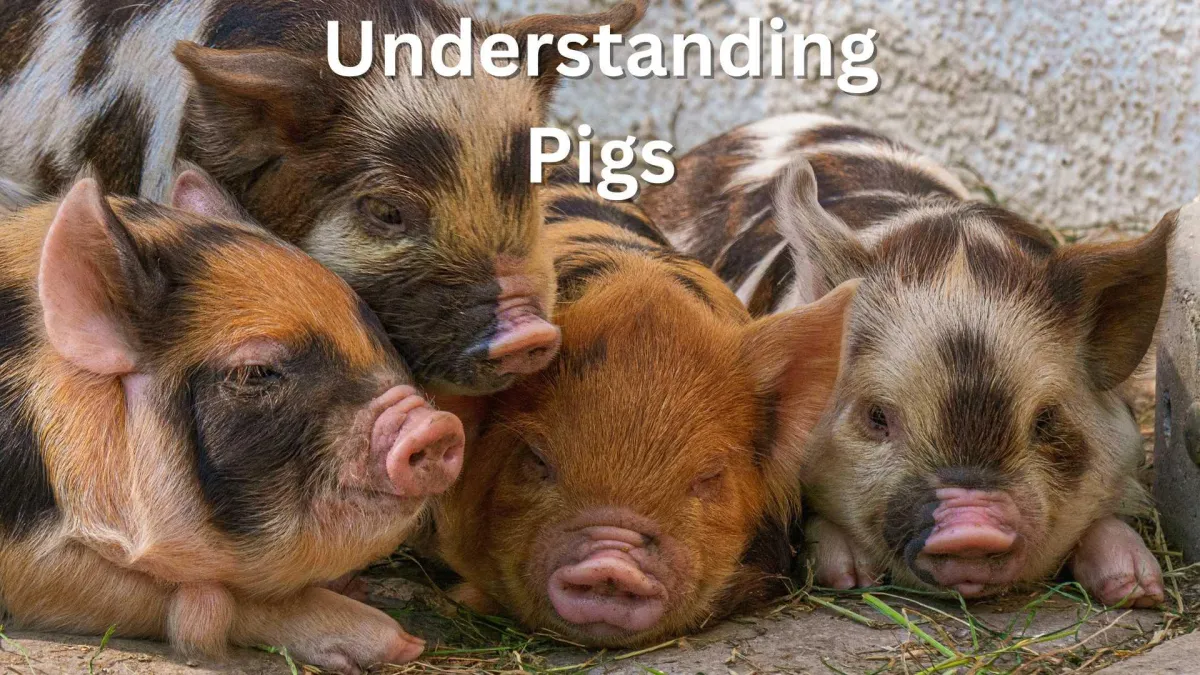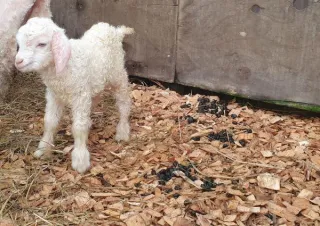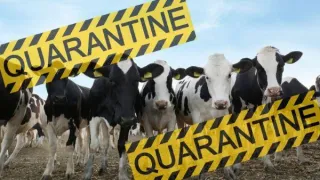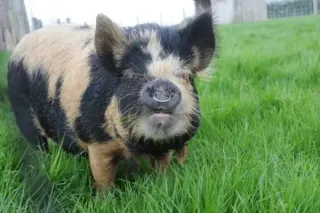Understanding Pigs

Behaviour, senses, and handling for the lifestyle farmer
Pigs are among the most intelligent and misunderstood animals you can keep on a lifestyle block. They’re clever, resourceful, highly social, and physically powerful. But they also demand the right environment, handling, and respect. What works for sheep or cattle won’t work for pigs, and treating them like either will make your life harder.
This guide is based on the writings of Dr Clive Dalton, adapted and expanded for lifestyle block owners who want to keep pigs well and safely. It explains how pigs think, what they need, and how to manage them confidently.
How Pigs Experience the World
Sight
Pigs have relatively poor vision. They can see movement and general shapes but have a limited field of view and weak depth perception. Their eyesight improves slightly with age but remains one of their less reliable senses.
Despite this, pigs can learn to recognise people visually and are surprisingly good at anticipating movement patterns, like a feed bucket coming around the corner.
They’re also sensitive to changes in light and shadow and may hesitate at doorways, changes in flooring, or unexpected objects.
Smell
This is a pig’s primary sense. Their sense of smell is extremely well developed, better than dogs in many cases, and they use it to:
Locate food
Identify other pigs
Detect pheromones
Explore unfamiliar environments
This is why pigs constantly root, sniff, and nudge. They’re interpreting the world through scent.
Hearing
Pigs have good hearing and are sensitive to sound tone and volume. They can distinguish voices, music, vehicle sounds, and feeding routines. Sudden loud noises can startle or agitate them, especially in confined areas like yards or trailers.
Using a calm, steady voice and avoiding shouting makes handling easier.
Touch
Pigs are tactile animals. They enjoy rubbing, nudging, and lying in contact with one another. They respond to stroking and scratching, especially if accustomed to human contact early on.
Social Behaviour and Hierarchy
Pigs are social animals and form complex social hierarchies. Groups of pigs, especially sows, establish clear dominance orders through pushing, vocal exchanges, and food access.
Once established, the hierarchy is usually stable unless new animals are introduced or space is restricted.
Young pigs raised together form strong bonds and tend to interact playfully. Isolated pigs become bored, destructive, or stressed. Boars are more solitary by nature but still benefit from sight and sound contact with others.
Communication
Vocalisations
Pigs are highly vocal and use a range of sounds to communicate:
Short grunts indicate contentment
High-pitched squeals signal distress, fear, or pain
Loud barks or growls are warnings or dominance displays
Low rumbles are used by sows to call piglets
They also grunt when exploring or when they recognise feeding routines. Each pig has a unique voice, and they can distinguish one another by sound.
Body Language
Watch for:
Raised hackles and stiff posture as signs of agitation
Nudging or mouthing as curiosity or social contact
Tail wagging indicating interest or contentment
Tail held tightly curled or still as a sign of discomfort
Daily Behaviour and Routines
Pigs divide their day between foraging, resting and wallowing, playing, and sleeping in close contact.
They are intelligent and active, and need mental stimulation. Without it, they become frustrated and destructive, chewing posts, damaging fences, or attacking other pigs.
Pigs love routine. Regular feeding and handling help build trust and reduce anxiety. They remember people, locations, and treatment, both good and bad.
Feeding Behaviour
Pigs are omnivores with a strong food drive. Feeding time is a major behavioural focus, and pigs can become aggressive or dominant if food access is limited or delayed.
Feeding should be:
Timed consistently
Evenly spaced to reduce competition
Monitored so smaller or timid pigs aren’t bullied away
Pigs root naturally. Providing rough ground, deep bedding, or enrichment feeding like scatter feeding improves welfare and keeps them occupied.
Breeding and Maternal Behaviour
Sows
Sows come into heat every 18 to 24 days. They show restlessness, vocalisation, and interest in the boar. During pregnancy, sows show nesting behaviour and can become protective or irritable.
As farrowing nears, the sow may separate herself, build a nest of straw or bedding, and become increasingly vocal. She uses grunts and low calls to communicate with her piglets.
Piglets
Newborn piglets are mobile within minutes and find a teat almost immediately. Competition is fierce and each piglet chooses a teat and defends it.
Piglets are sensitive to cold, crushing, and disease in the early days. Handling should be minimal, gentle, and stress-free.
Handling and Restraint
Pigs dislike being forced or surprised. Good handling requires a calm approach, consistent routine, and clear boundaries.
They are easily trained using food, and many lifestyle block owners use a rattle bucket or calling voice to guide pigs between paddocks or pens.
Never grab a pig by a leg or ear. This causes extreme stress and pain. Instead:
Use pig boards (solid panels) to guide them
Lead them with feed
Work in pairs if possible
Moving pigs is easier if the area is well lit, quiet, and not slippery.
Fencing and Containment
Pigs test boundaries constantly. Effective fencing must be:
Strong, with buried wire or hotwire to prevent digging
High enough to deter jumping
Free of sharp edges or gaps
Electric fencing works well if pigs are trained to it. Begin with visible tape and a strong pulse. Most pigs respect hotwire after one or two shocks.
Shelter and dry bedding are essential. Pigs hate cold winds and damp, and will seek shelter instinctively.
Enrichment and Welfare
Bored pigs are destructive and hard to manage. Enrichment can include:
Logs or chains to chew and move
Deep straw for rooting
Objects to push or roll
Safe outdoor access
Pigs need social contact. Isolated pigs can become depressed or aggressive. Keep them in compatible pairs or groups.
Final Thoughts
Pigs aren’t pets, but they’re not just stock either. Their intelligence, emotional awareness, and physical strength mean they need careful management, consistent handling, and secure housing.
Handled well, pigs are trainable, responsive, and a joy to raise. But underestimate them, and they’ll soon be running the block.
More Resources
Pigs are very intelligent and deserve the best. Here's a few ways you can upskill:
What You Need to Know to Keep Pigs – It's hard to find NZ-based, lifestyle farming advice on keeping pigs but it's all here.
What You Need to Know to Keep Livestock – A quick look at everything from the needs of different species to your legal reponsibilities.
Considering other livestock?
Understanding Cattle – The most common of the grazing species - and the largest!
Understanding Equids – Donkeys have amazing characters too.
Understanding Poultry - A few chooks running around make a farm a home.
Back to Livestock & Pets
More articles on pigs

What Your Animal's Poo Is Telling You
Learn how to interpret changes in your animal's faeces. From colour and texture to parasites and digestive disorders, these signs can help identify health issues early. ...more
The Basics ,Sheep Cattle Goats Pigs &Alpaca
July 22, 2025•4 min read

Quarantining New Animals - What, When, and How
Preventing the spread of disease on your farm starts with strong biosecurity measures. Quarantining new animals for 2-3 weeks helps detect infections, clear parasites, and ensure a healthy flock. Lear... ...more
The Basics ,Sheep Cattle Goats &Pigs
March 17, 2025•8 min read

Dealing with an emergency (while waiting for the vet)
When an emergency strikes your livestock, quick action is key. While waiting for the vet, follow these essential steps to keep your animal safe, calm, and stable. Learn how to secure the patient, mana... ...more
The Basics ,Sheep Cattle Poultry &Pigs
February 24, 2025•8 min read

Kunekune Nutrition
Discover essential tips for Kunekune pig nutrition! Learn how to prevent obesity, meet protein needs, and balance their diet for happy, healthy pigs. Perfect for small-scale farmers and pet owners. ...more
Pigs
January 23, 2025•6 min read

Design the Perfect Pig Enclosure
Explore practical tips for managing pig behaviors like rooting and wallowing sustainably. Learn how to maintain pasture health, create pig-safe enclosures, and integrate pigs into a permaculture syste... ...more
Pigs
December 18, 2024•6 min read

News Alert for all owners of pigs: Influenza A (H1N1) - initially called swine flu
NZPork, the organisation funded by New Zealand pork producers has important information for all owners of pigs. ...more
Pigs
December 31, 2022•2 min read
Support & Legal
Get Rural Tips & Seasonal Updates
Subscribe to the LSB monthly newsletter.
© 2025 Lifestyleblock.co.nz | LSB Ltd Proudly off-grid and NZ-owned

